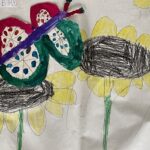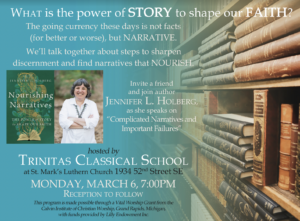 We celebrate the enthusiastic responses to Mrs. Tellinghuisen’s biblical storytelling workshop at the Calvin University Worship Symposium. About 70 people attended and heard about Mrs. Tellinghuisen’s multi-media, multi-sensory story projects. Thanks to the 7/8 class for participating in the workshop and blessing the attendees with their enactment from Matthew 18, the Parable of the Unmerciful Servant.
We celebrate the enthusiastic responses to Mrs. Tellinghuisen’s biblical storytelling workshop at the Calvin University Worship Symposium. About 70 people attended and heard about Mrs. Tellinghuisen’s multi-media, multi-sensory story projects. Thanks to the 7/8 class for participating in the workshop and blessing the attendees with their enactment from Matthew 18, the Parable of the Unmerciful Servant.
Mrs. Tellinghuisen spoke about how we can help learners (of all ages) to grow in the knowledge and wonder and love of God’s word by encouraging them to tell stories using all of our senses. Here is a story based on an experience she shared:
***
 Once upon a time, there was a Trinitas kindergartener who loved art, but art class could be stressful because it’s hard to capture the essence of one’s creative impulse. That’s true whether you are five years old or fifty years old. And indeed, occasionally this young artist would grow frustrated with the process and disappointed with the product. So when tears appeared one day during class, the teacher came over to see what the problem was.
Once upon a time, there was a Trinitas kindergartener who loved art, but art class could be stressful because it’s hard to capture the essence of one’s creative impulse. That’s true whether you are five years old or fifty years old. And indeed, occasionally this young artist would grow frustrated with the process and disappointed with the product. So when tears appeared one day during class, the teacher came over to see what the problem was.
The assignment was to draw colorful flowers on a large piece of paper, then paint a bright butterfly on a separate piecer of paper, cut it out, and paste it on the floral background. The young student was inconsolable. But it didn’t appear to be a case of pernicious perfectionism. The flowers were lovely, the art teacher said. And the butterfly was exactly what this student had envisioned. So why the tears?
Let’s pause for a moment so we don’t lose sight of the fact that stories are both windows and mirrors. Let’s use this one as a mirror right now. When you are upset, anxious, scared, or angry, do you find it hard to think straight and communicate clearly? Do emotions ever hit you so quickly and so fiercely that you don’t even know why you are feeling what you are feeling? If so, then you have entered a place of solidarity with this budding artist. And perhaps you have also discovered that when you can stop, breathe, and maybe even get a hug, the situation can change for the better. You’ve found space to find your voice.
Window time. We’re back at Trinitas. The art teacher, concerned for the student but struggling to understand what was needed in the moment, found the artist’s mother and said she was needed in the art room.
Stop. Breathe. Hug.
Mom: Can you show me your art? This is wonderful. Tell me about it. So what are you supposed to do next? Why don’t you want to glue your butterfly on those flowers?
Artist: Because then I can’t tell a story with it.
Kids say the wisest things. Butterflies fly. And wouldn’t a loving artist want to pick up that beautiful creation and let it flutter—up and down and here and there—before it lands for a sip of nectar? No glue needed here. Maybe just a small piece of tape to keep that butterfly attached to its flower while on display during Fine Arts Night. But then, set it free and see where it goes.
There’s nothing wrong with sitting down and reading a book. Some stories are made for curling up on a cozy couch. But next time you tell a story, see if there might be some way for you to pick it up and let it soar!
© RRT, February 2025






